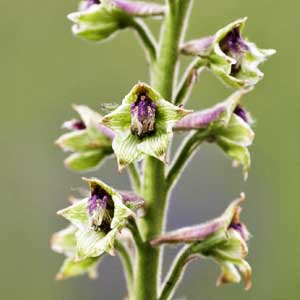Delphinium bicolor
Delphinium viridescens
Flathead larkspur, little larkspur, low larkspur, Montana larkspur
Wenatchee larkspur
10-40(-70) cm;
base often reddish, glabrous to puberulent.
90-150 cm;
base usually green, glabrous.
blade round, 1-4 × 1.5-7 cm, glabrous to puberulent; ultimate lobes 3-19, width 1-8 mm (basal), 1-3 mm (cauline).
blade cuneate to semicircular, 2-5 × 3-12 cm, nearly glabrous; ultimate lobes 3-21, width 1-8 mm.
3-12(-22)-flowered;
pedicel 1-4(-8) cm, ± puberulent;
bracteoles 2-7(-17) mm from flowers, green, sometimes white-margined, lanceolate, 4-6(-8) mm, puberulent.
25-80-flowered, dense;
pedicel 0.5-2 cm, glandular-pubescent;
bracteoles 1-4 mm from flowers, green, lanceolate, 3.5-6 mm, glandular-pubescent.
sepals dark blue, puberulent, lateral sepals usually spreading, 16-21 × 6-12 mm, spurs straight to gently decurved, ascending 0-40° above horizontal, 13-23 mm;
lower petal blades covering stamens, 7-12 mm, clefts 0.1-3 mm;
hairs sparse, short, mostly on inner lobes below junction of blade and claw, white or yellow.
sepals yellowish green, nearly glabrous, lateral sepals forward pointing, 7-9 × 3-4 mm, spurs decurved, 30-45° below horizontal, often hooked apically, 8-11 mm;
lower petal blades ± covering stamens, 4-6 mm, clefts 0.5-1.5 mm;
hairs centered, mostly near junction of blade and claw, yellow.
(12-)16-22 mm, 4-4.5 times longer than wide, usually puberulent.
8-11 mm, 2.5-3 times longer than wide, puberulent.
often winged;
seed coat cells with surfaces ± smooth.
± wing-margined;
seed coat cells with surfaces ± roughened.
Delphinium bicolor
Delphinium viridescens
Subspecies 2 (2 in the flora).
Delphinium bicolor is closely related to D. glareosum; it differs in its wider-lobed cauline leaves, shallower petal clefts, and narrower fruits.
The Gosiute consider this plant to be poisonous (D. E. Moerman 1986, subspecies not specified).
(Discussion copyrighted by Flora of North America; reprinted with permission.)
Of conservation concern.
Delphinium viridescens is local in mountains southwest of Wenatchee, Washington.
(Discussion copyrighted by Flora of North America; reprinted with permission.)
1. Sepals (especially in fresh material) dark blue to purple; cleft in lower petals 2 mm or less; soils not derived from limestone. | subsp. bicolor |
1. Sepals (especially in fresh material) bright dark blue; cleft in lower petals at least 2 mm; soils derived from limestone. | subsp. calcicola |


